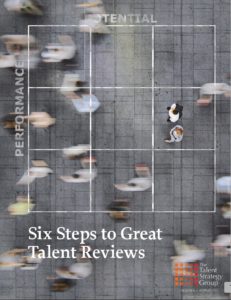Six Steps to Great Talent Reviews

Most companies hold talent reviews. Few execute them to their maximum benefit.
By Marc Effron, President, Talent Strategy Group
It’s great news that talent reviews have become almost universal in larger organizations, avoiding the fads that have overtaken HR processes like performance management. The fact that most companies do them, however, doesn’t mean that they’re done well. We often see companies with overly complex processes, vague definitions of potential, ill-equipped HR leaders, no follow up and other challenges that undercut the effectiveness of this potentially powerful process.
Our experience conducting hundreds of talent reviews and building the process for complex global companies shows us that six factors create a successful talent review:
1. A Crisp, Company-Specific Definition of Potential
In our classic article Your Potential Model is Wrong, we found significant issues with the two most popular potential models. In both models, items that the consulting firms claim predict potential actually predict performance, there’s no independent scientific evidence that either model is valid and neither model takes into account how an individual fits with a company’s specific needs.
Rather than using a generic potential model, we suggest you create a company-specific definition of potential that includes the following elements:
- A track record of sustained high performance across fundamentally different challenges. Past performance in one job tells us little about future performance in a different job. But, sustained high performance across different, highly challenging scenarios indicates high cognitive capability (IQ) and provides insights about resilience, ambition and other critical personality factors that predict potential (1).
- Fit with the 3 – 4 capabilities your strategy requires. In Companies Change but Leaders Don’t, we describe how an individual’s fit with their company’s future needs helps predict their potential. Use the Executive Fit Matrix in that article to determine the 3 – 4 capabilities that will differentiate your highest performing leader in the next 3 – 5 years. Ignore “good citizen” behaviors and focus on defining outcomes that your top talent will deliver. Read Life After the Competency Model to learn now to identify and present to these differentiators.
2. A Light Process
You should be able to conduct a talent review with two sheets of paper – a 9-box grid (or your favorite tool) and a succession chart. A talent review is an operational process to keep your Talent Production Line moving forward, so any material that doesn’t directly assist in that process isn’t needed. This includes things like employee profile development and maintenance that we consider to be among a company’s most wasteful activities. Likewise, summary charts, statistics and other superfluous material don’t improve your ability to predict a leader’s potential or develop it.
3. Manager Accountability
Managers should be able to describe their team members’ strengths, weaknesses, behaviors and next development steps without the crutch of employee profiles. This is not a high bar – it’s a fundamental expectation of a manager. In a talent review, they should also be able to ask smart questions about their peers’ direct reports to ensure that their peers can justify their ratings. This doesn’t require that they know their peers’ talent (although that helps), but that they ask how a person compares to others rated similarly, what the next development steps are for that individual and how committed they are to their rating. Questions like, “Are you willing to stake your corporate reputation on this individual?” are a great way to test their true knowledge and commitment.
4. Savvy Facilitation
An HR leader should facilitate talent review conversations until the organization is experienced and capable enough for line leaders to do this on their own. Before the talent review, an HR leader should meet with every leader who will present talent in the meeting to review their assessments and screen for any controversial choices. In the talent review, savvy facilitation means:
- Fact-based discussions: The only facts discussed are those most relevant to accurately place and invest in an individual. Ad hominin comments are quickly shut down as are irrelevant comments about universities attended, marital status, etc.
- An independent view from HR: Whenever possible, HR should have an independent view about the talent being discussed and actively participate in the discussion. HR is the neutral player in the organization, interested only in the best overall outcome. If they do not have that point of view their role in the meeting is reduced to simply facilitating – a task that could be given to anyone with facilitation skills.
5. Development Decisions For All High Potentials
In your talent review session, you will have thoroughly discussed each high potential’s strengths, weaknesses and development needs. You will have calibrated that the group agrees with those findings. You will have the right people in the room to make smart, aligned decisions about that high potential’s next development steps. This means that a key output of a high-quality talent review is to identify the primary development action for each high potential. When you make this decision in the meeting, you have the benefit of not only having holistic input from your peers but also their alignment and support of that decision.
6. Flawless Follow Up
It’s sometimes the simplest steps that trip companies in their talent review process. Talent reviews mean nothing without follow-up on the decisions made. We frequently see companies that hold fact-based, disciplined talent reviews and then fail to take the actions they committed to take. Flawless follow up is easier than it sounds and includes:
- HR records every decision made: If it’s decided that the company should move Suzie to Kuala Lumpur next year, this action should be recorded along with the person responsible for that action and the date due.
- HR follows up monthly: Once a month, the HR leader who facilitated the process or owns the outcome should check with the leader for each action item to see if that action has occurred. They should offer to help move the process forward if the leader isn’t moving quickly enough.
- Integrate reporting into regular group meetings: Most functions or regions have a regular meeting cycle and talent review follow-up should be integrated into that. The status of talent review actions should be tracked and reported just like any key financial or operational metric.
There’s no company process more important than accurately selecting and investing in your future leaders. Poor choices place your business at risk, waste investments and derail careers. A well-run process takes standards, process and discipline, but is completely achievable by companies of every size. Start by committing your company to flawlessly execute the six steps guaranteed to produce great results.
1) Barrick, Murray R., Michael K. Mount, and Timothy A. Judge. “Personality and performance at the beginning of the new millennium: What do we know and where do we go next?.” International Journal of Selection and Assessment 9, no. 12 (2001): 9-30.

More About The Author:
- Marc Effron, President, Talent Strategy Group
- Marc founded and leads The Talent Strategy Group and consults globally to the world’s largest and most successful corporations. He co-founded the Talent Management Institute and created and publishes TalentQ magazine. He co-authored the Harvard Business Review Publishing best-seller One Page Talent Management and 8 Steps to High Performance.